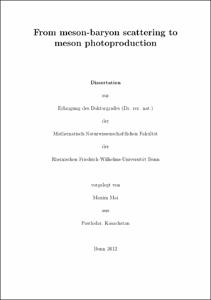Mai, Maxim: From meson-baryon scattering to meson photoproduction. - Bonn, 2013. - Dissertation, Rheinische Friedrich-Wilhelms-Universität Bonn.
Online-Ausgabe in bonndoc: https://nbn-resolving.org/urn:nbn:de:hbz:5n-30949
Online-Ausgabe in bonndoc: https://nbn-resolving.org/urn:nbn:de:hbz:5n-30949
@phdthesis{handle:20.500.11811/5606,
urn: https://nbn-resolving.org/urn:nbn:de:hbz:5n-30949,
author = {{Maxim Mai}},
title = {From meson-baryon scattering to meson photoproduction},
school = {Rheinische Friedrich-Wilhelms-Universität Bonn},
year = 2013,
month = jan,
note = {In the present work we investigate the properties of the lowest baryon resonances. The starting point of our analyses is the low-energy effective theory of quantum chromodynamics, called chiral perturbation theory. As such it describes the long-range observables in terms of the lowenergy effects, while the high-energy effects are subsumed in the so-called low-energy constants. In the region of the aforesaid lowest baryon resonances any strict perturbative expansion fails and some resummation scheme is required. For this we will employ the Bethe-Salpeter equation (BSE) which guarantees the exact unitarity of the S-matrix and allows to generate resonances dynamically, however, abandoning some other basic principles of quantum field theory as described in chapter 2. Restricting the driving term of this equation to local terms of the second chiral order, we will derive an exact solution of the BSE for meson-baryon scattering in chapter 2. Without putting the interaction kernel on shell we preserve the exact correspondence of this solution to an infinite chain of Feynman diagrams.
In chapter 4 we will apply this ansatz for antikaon-nucleon scattering, trying to get a new insight into the nature of the subthreshold resonance, i.e. Λ(1405). The properties of this resonance have been debated for decades and in recent years it has again attracted a lot of attention by theoreticians since this resonance can be dynamically generated from the so-called chiral unitary approaches. Moreover, the recent measurement of the energy shift and width of kaonic hydrogen in the SIDDHARTA experiment at DAΦNE has provided a very tight constraint on K‾p scattering length. Typically, these approaches predict a two pole structure of Λ(1405), but the question is how precise one can determine the position of these poles relying on data at and above the ‾K N threshold.
Moreover, we will apply our framework for the analysis of pion-nucleon scattering in chapter 3. There we will show that the iteration of local terms of second chiral order allows to reproduce the s-wave resonances N*(1535)S11 and N*(1650)S11. Then in chapter 5 we will adopt this hadronic amplitude as a part of a gauge invariant framework to address pion and eta photoproduction in a combined analysis. There all terms of the next-to-leading chiral order will be included reproducing the scattering data very well in both channels. After that we calculate the photoproduction multipoles in a parameter-free prediction which will then be compared with more phenomenological analyses by the MAID, ETAMAID, SAID and Bonn-Gatchina groups.},
url = {https://hdl.handle.net/20.500.11811/5606}
}
urn: https://nbn-resolving.org/urn:nbn:de:hbz:5n-30949,
author = {{Maxim Mai}},
title = {From meson-baryon scattering to meson photoproduction},
school = {Rheinische Friedrich-Wilhelms-Universität Bonn},
year = 2013,
month = jan,
note = {In the present work we investigate the properties of the lowest baryon resonances. The starting point of our analyses is the low-energy effective theory of quantum chromodynamics, called chiral perturbation theory. As such it describes the long-range observables in terms of the lowenergy effects, while the high-energy effects are subsumed in the so-called low-energy constants. In the region of the aforesaid lowest baryon resonances any strict perturbative expansion fails and some resummation scheme is required. For this we will employ the Bethe-Salpeter equation (BSE) which guarantees the exact unitarity of the S-matrix and allows to generate resonances dynamically, however, abandoning some other basic principles of quantum field theory as described in chapter 2. Restricting the driving term of this equation to local terms of the second chiral order, we will derive an exact solution of the BSE for meson-baryon scattering in chapter 2. Without putting the interaction kernel on shell we preserve the exact correspondence of this solution to an infinite chain of Feynman diagrams.
In chapter 4 we will apply this ansatz for antikaon-nucleon scattering, trying to get a new insight into the nature of the subthreshold resonance, i.e. Λ(1405). The properties of this resonance have been debated for decades and in recent years it has again attracted a lot of attention by theoreticians since this resonance can be dynamically generated from the so-called chiral unitary approaches. Moreover, the recent measurement of the energy shift and width of kaonic hydrogen in the SIDDHARTA experiment at DAΦNE has provided a very tight constraint on K‾p scattering length. Typically, these approaches predict a two pole structure of Λ(1405), but the question is how precise one can determine the position of these poles relying on data at and above the ‾K N threshold.
Moreover, we will apply our framework for the analysis of pion-nucleon scattering in chapter 3. There we will show that the iteration of local terms of second chiral order allows to reproduce the s-wave resonances N*(1535)S11 and N*(1650)S11. Then in chapter 5 we will adopt this hadronic amplitude as a part of a gauge invariant framework to address pion and eta photoproduction in a combined analysis. There all terms of the next-to-leading chiral order will be included reproducing the scattering data very well in both channels. After that we calculate the photoproduction multipoles in a parameter-free prediction which will then be compared with more phenomenological analyses by the MAID, ETAMAID, SAID and Bonn-Gatchina groups.},
url = {https://hdl.handle.net/20.500.11811/5606}
}






